
Contents
Who would have thought, a few years ago, that one day we would be on the hunt for solutions that meet strategy and technology for answering the necessity of governing systems that still seemed to be the thing of science fiction?
Yet, here we are. Artificial intelligence is a present-day reality, driving innovation across major industry verticals, including Insurance, Banking and Investment, Retail, Healthcare, HR, Technology, Telecommunications, and Utilities. As organizations integrate these powerful AI systems into their core operations, the potential for significant gains is matched only by the potential for substantial risk.
This is where AI governance comes in. This all-encompassing term entails the framework of rules, policies, standards, and processes that ensure an organization’s AI technologies are developed and used in a way that is ethical, fair, transparent, and compliant with laws and regulations. The necessity for AI governance stems from the need to manage risks like algorithmic bias, data privacy violations, lack of transparency, and potential for errors that can have serious financial and reputational consequences.
Selecting the right AI governance platform is a critical step in this journey. The process involves identifying your organization’s specific needs, understanding the regulatory landscape of your industry, and evaluating platforms based on their ability to provide comprehensive oversight and control over your AI ecosystem.
To help you make an informed decision, we’ve compiled a list of the essential features an AI governance platform must have. We’ll be highlighting these critical capabilities through the lens of Lumenova AI.
→ Born from a team with over 15 years of experience in machine learning and deep expertise in Explainable AI, Lumenova AI was founded to bridge the gap between human and machine intelligence. We are your friendly, expert-driven company dedicated to opening the “black box” of AI, making it more understandable, trustworthy, and ready for business. Our goal is simple: to help businesses innovate fearlessly by making Responsible AI a core part of their operations.
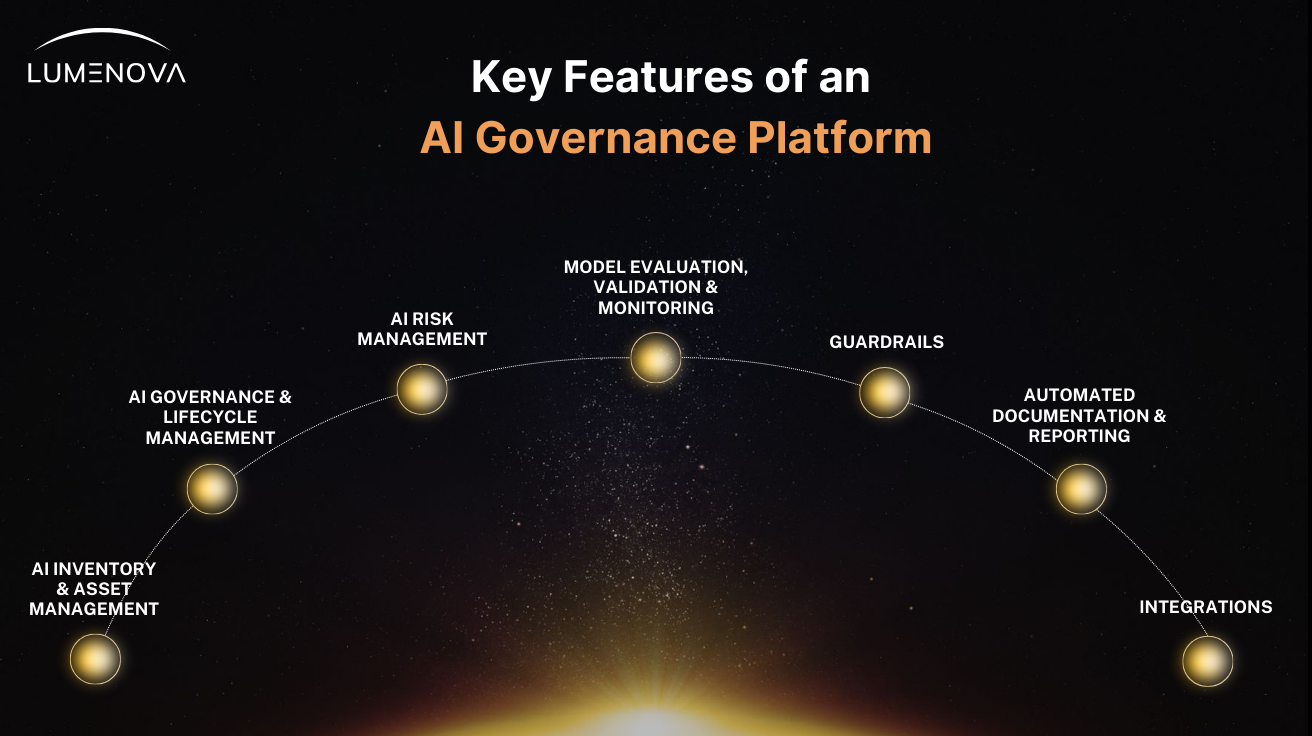
1. AI Inventory and Asset Management
An effective governance strategy begins with visibility. You need a central hub for all AI models and associated data across your entire organization, creating a single source of truth. This “AI Registry” is foundational for tracking, managing, and governing every AI asset.
Key features include:
Model Cards
Detailed documentation for each model, integrating performance metrics and historical insights to support data-driven decision-making and ensure transparency.
Benchmarking
The ability to compare models across different vendors, architectures, datasets, and hyperparameters to select the best-performing and most appropriate solution for any given use case.
→ With Lumenova AI, you can maintain a full catalog of all AI models, comprehensively documenting every system used across your organization to ensure nothing operates in the shadows. Our AI inventory and asset management system is designed to map, classify, and document all AI systems across the enterprise, identify risks, owners, and compliance gaps.
2. AI Governance & Lifecycle Management
This is the command center for ethical AI at scale. An automated governance framework allows you to set, manage, and automatically enforce company-wide rules, policies, and approval workflows for how AI is built and used. It is the foundation of building trust in your AI solutions.
Frameworks Library
Direct access to a curated library of regulatory and industry frameworks ensures your operations are compliant with evolving standards.
→ Lumenova AI offers coverage for over 19 frameworks, including: NIST AI RMF, EU AI Act, Colorado Regulation 10-1-1, ISO 42001, and NYC Local Law 144.
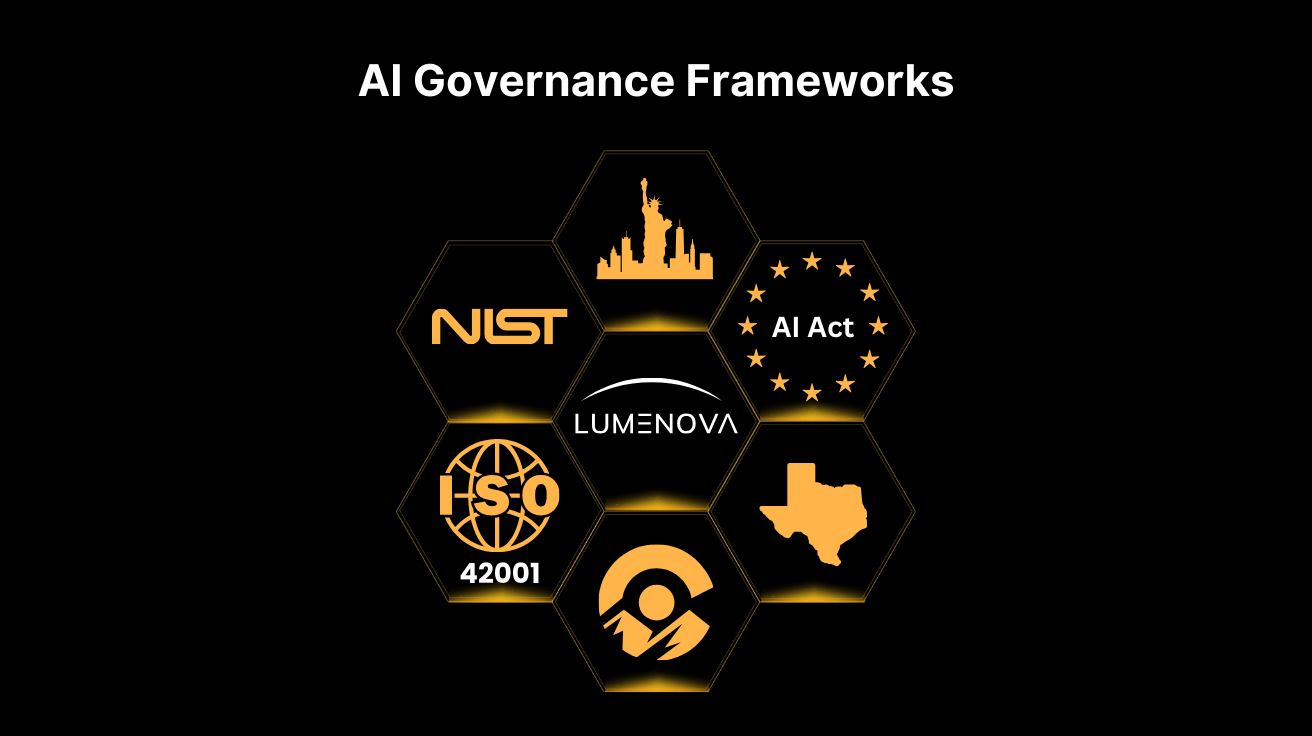
Key features include:
Quick Framework Alignment
The ability to easily map your AI use cases and internal controls to any framework, rapidly identifying compliance gaps and accelerating your path to being audit-ready.
→ With Lumenova AI, you can import any list of frameworks and controls directly into your dashboard.
Controls Repository
Mechanisms to document how each internal control demonstrates compliance with a specific framework.
→ Lumenova AI allows controls to be documented and used in combination to satisfy multiple requirements.
AI Lifecycle Management
Tools to define, document, and continuously monitor the compliance journey of your AI use cases from conception to retirement.
→ Lumenova AI guides clients from model design to deployment and retirement, building processes for model monitoring, retraining, and responsible AI use.
3. AI Risk Management
A robust platform must identify and score a wide spectrum of risks, from ethical bias and regulatory non-compliance to technical model failures, and provide the tools to mitigate them. This is your path to innovating fearlessly without the risk of negative headlines.
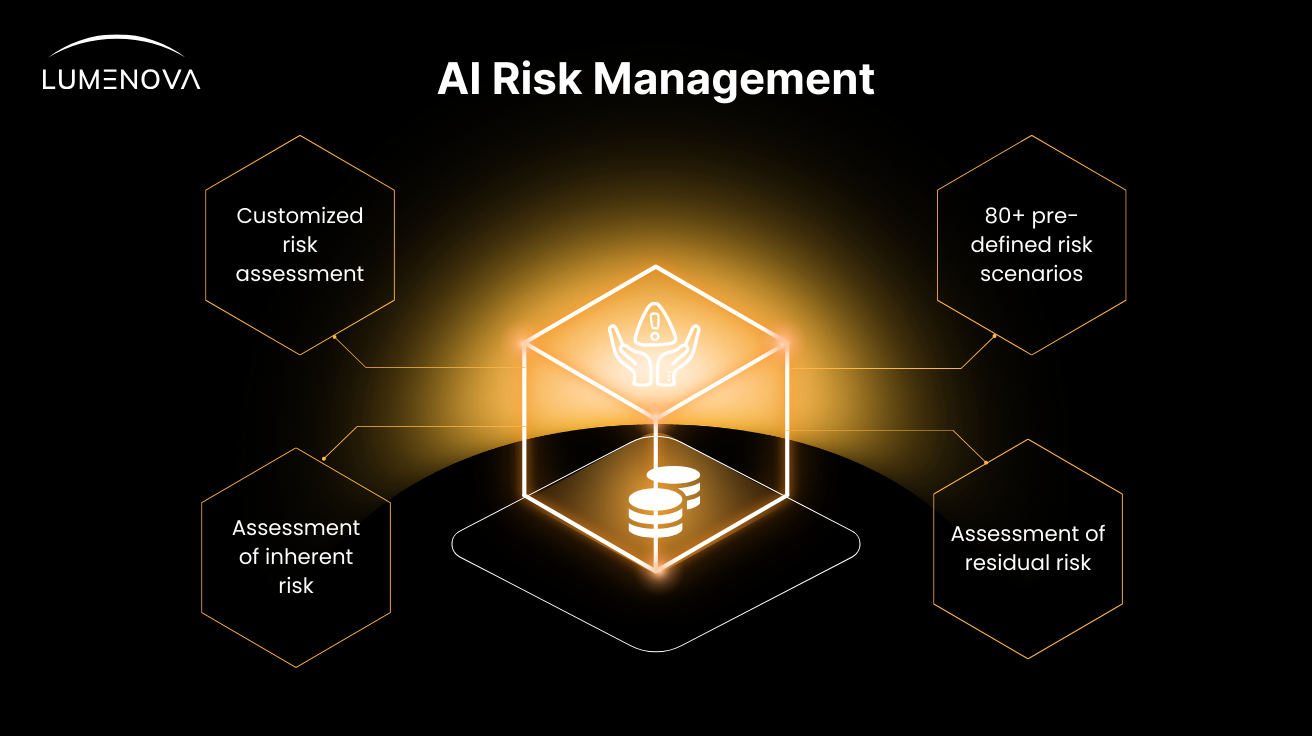
Key features include:
AI Risk Scenario Library
A library of predefined risk scenarios, categorized and mapped to industry frameworks, helps streamline risk assessments and enable proactive mitigation.
→ Lumenova AI comes equipped with a library covering over 80 risk scenarios.
Customized Risk Assessments
The capability to review all risks identified for your business and develop a comprehensive treatment plan for each one.
Assessment of Inherent and Residual AI Risk
Using inherent and residual risk matrices to understand your risk exposure before and after mitigation controls are applied, helping you minimize exposure and maximize ROI.
→ Lumenova AI provides full support for both customized assessments and the measurement of inherent and residual risk.
4. Model Evaluation, Validation & Monitoring
This feature set acts as the checks and balances for your AI. It involves continuously watching models for performance degradation and conducting deep, independent testing to validate that they are accurate, fair, transparent, and reliable over the long term.
Key features include:
Traditional (Predictive) ML & GenAI Models Evaluation
The AI governance platform you choose must support seamless evaluation for both traditional machine learning models and the latest Generative AI models.
Speaking of GenAI evaluations, besides foundation models (LLMs like Azure OpenAI, Anthropic, Gemini, Meta LLama, and other open source models), you should also take into consideration the evaluation and monitoring of RAGs and embedding models.
→ For foundation and fine-tuned GenAI models, Lumenova AI watches for performance, fairness, robustness, and hallucinations. In the case of RAG applications, we evaluate and monitor the overall performance, as well as the retriever and generator performance.
Continuous Monitoring
Ongoing evaluation of performance, robustness, fairness, and explainability is crucial to ensure long-term model reliability.
Model Insight Metrics
Deep visibility into a wide array of metrics is necessary to proactively manage AI risk and build stakeholder trust.
→ Lumenova AI offers over 200 metrics for comprehensive model analysis. We validate and stress-test AI systems for performance, fairness & bias, explainability, and robustness – through dedicated sets of custom metrics for both traditional ML and GenAI models.
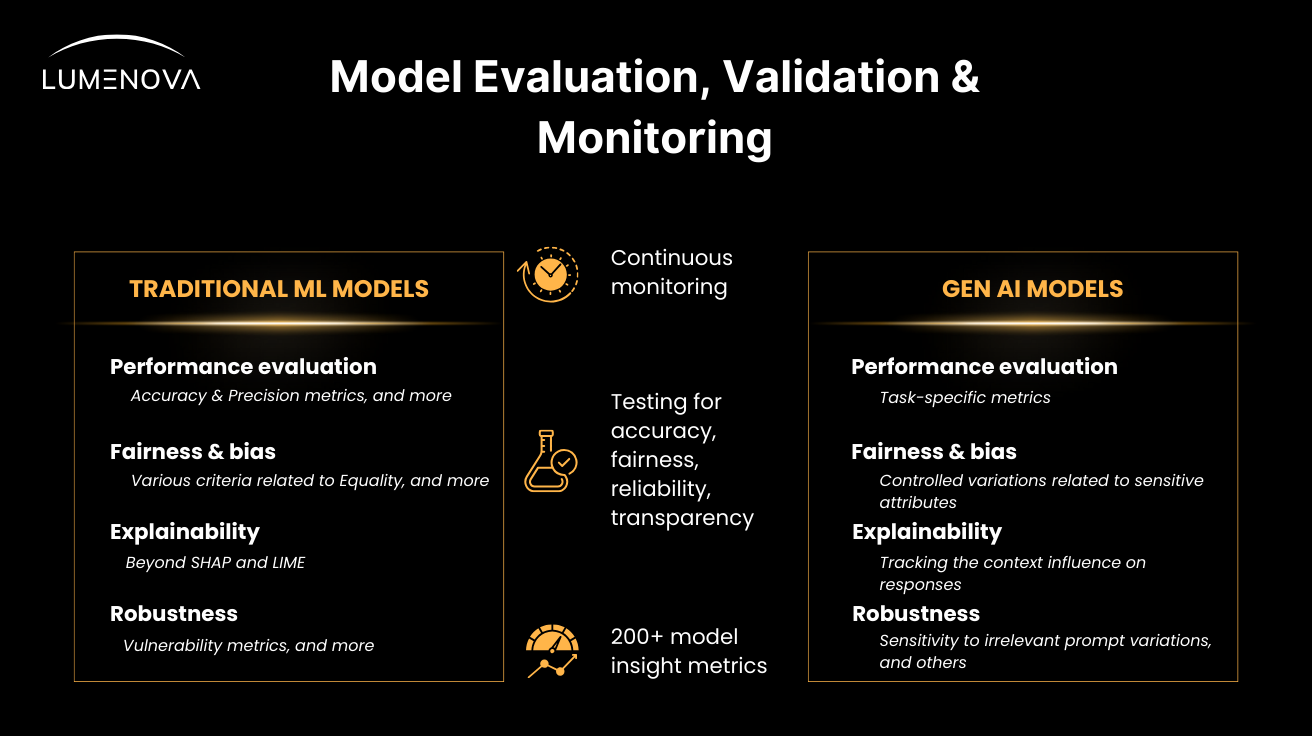
5. Guardrails and Evaluators
Guardrails ensure your AI system operates securely within its intended boundaries, minimizing the risk of harmful, misleading, or inappropriate outputs. The AI governance platform should actively monitor for policy violations or performance degradation and send instant alerts so issues can be addressed before they become critical.
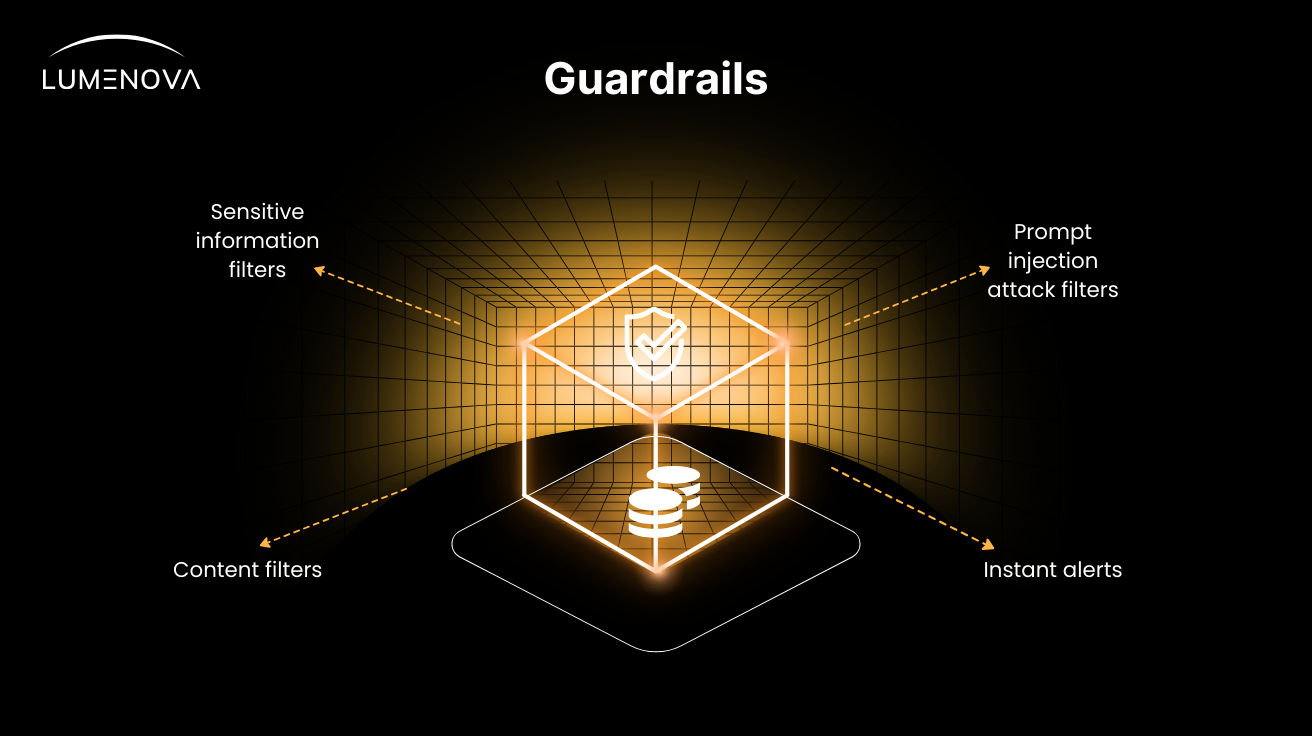
→ Lumenova AI offers a comprehensive set of guardrails, including:
- Sensitive information filters: Automatically detect and anonymize PII to protect user privacy.
- Prompt injection attack filters: Shield AI systems from malicious user inputs designed to bypass safeguards.
- Content filters: Identify and block harmful or inappropriate content in both user inputs and model responses (for toxicity, bias, hallucinations).
Through these guardrails, we design and implement real-time content safety & privacy protection, safeguarding both user input and AI system output.
6. Automated Documentation and Reporting
To prove compliance and maintain transparency, your AI governance platform of choice must automatically generate comprehensive documentation and reports. This includes documenting the compliance status at both the framework level and the individual model level.
→ Lumenova AI offers robust automated documentation and reporting capabilities to satisfy audit and regulatory requirements.
7. Integrations & Interoperability
Finally, an AI governance platform cannot operate in a silo. It must connect directly into your existing technology stack, embedding governance and risk checks into the data pipelines, development tools, and operational workflows that your teams already use. This ensures that governance is not an afterthought but an integrated part of the AI lifecycle.
Take the Next Step in Your AI Governance Journey
Choosing the right AI governance platform is a strategic decision that empowers you to innovate responsibly and build lasting trust in your AI systems.
Are you ready to move beyond theoretical concepts to actually see how an AI governance platform can fit your business cases? Or perhaps you simply wish to talk to a specialist who can give you customized information on any of the features we’ve discussed?
We invite you to book a personalized demo of Lumenova AI today and discover how we can help build a future of trustworthy, compliant, and effective AI for your organization.